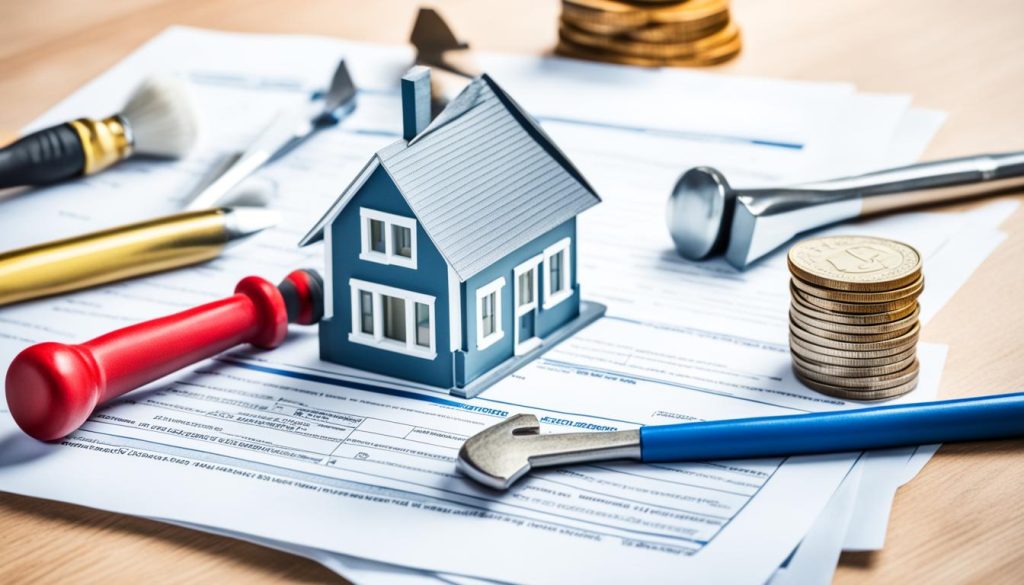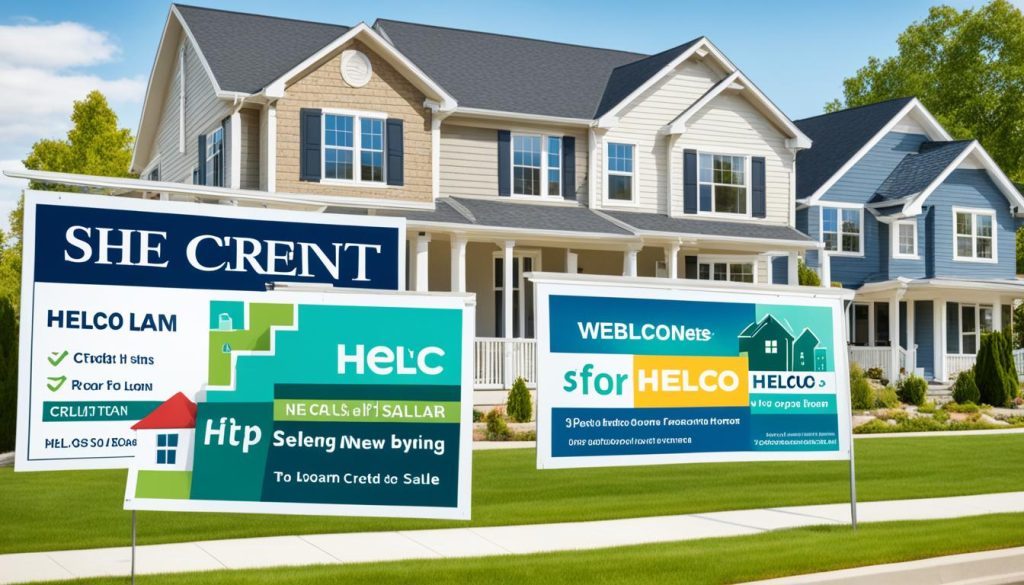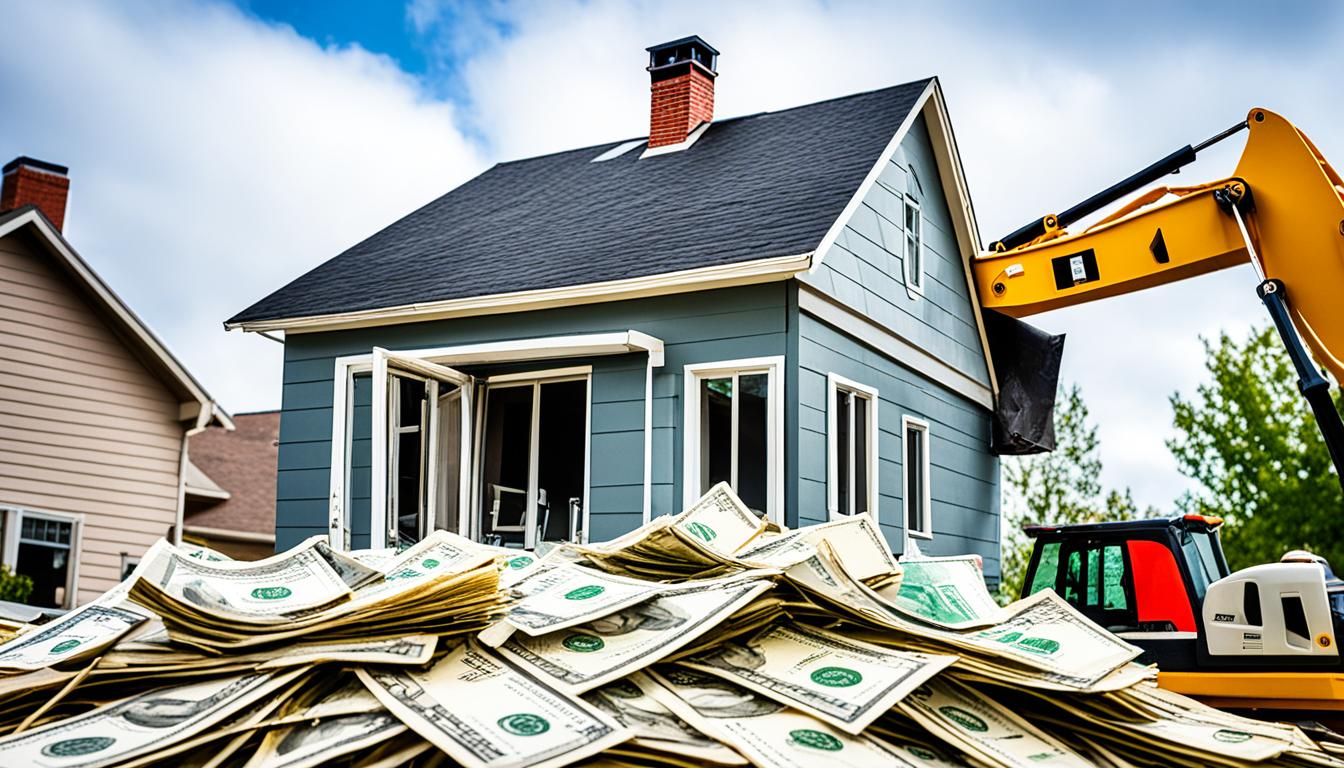Did you know that many Canadians are seeking innovative ways to finance their home renovations? If you’re looking to bring your dream home to life, adding the costs of renovations to your mortgage could be a game-changing solution. Not only does it simplify your finances, but it also provides a cost-effective option for transforming your property. In this article, I will explore how you can add renovation costs to your mortgage in Canada and the various financing options available.
Key Takeaways:
- Adding renovation costs to your mortgage in Canada can simplify your finances and make your dream home a reality.
- A renovation mortgage is a loan secured against real estate for the purpose of renovations, offering lower interest rates and lower monthly payments compared to other financing options.
- There are two main ways to add renovation costs to your mortgage in Canada: through mortgage refinancing or using a purchase plus improvement mortgage.
- Alternative financing options for home renovations include using savings, credit cards, unsecured credit lines, secured credit lines, personal loans, or loans from family members.
- When exploring your home renovation financing options, consider factors such as interest rates, monthly payments, loan amounts, and repayment terms to choose the best option for your needs.
What is a Renovation Mortgage?
A renovation mortgage is a loan secured against real estate for the purpose of renovations. It allows homeowners to add the costs of renovations to their mortgage, making it easier to finance their home improvement projects. The terms of the loan, including the amount, interest rate, and length, depend on the type of renovation mortgage you choose.
There are various home renovation finance options available, including using savings, credit cards, unsecured credit lines, secured credit lines, personal loans, and loans from family members. However, a renovation mortgage loan offers several advantages:
- Lower interest rates: Compared to other financing options, a renovation mortgage typically offers lower interest rates, resulting in potential savings over the loan term.
- Lower monthly payments: With a renovation mortgage, you can spread the cost of renovations over the term of your mortgage, resulting in lower monthly payments compared to other financing options.
- Access to a higher loan amount based on home equity: The equity in your home can be used to secure a renovation mortgage loan, allowing you to access a higher loan amount than other financing options may offer.
Overall, a renovation mortgage loan is a good option for borrowers who want to avoid the flexibility of other financing options and have a clear plan for their home improvement projects. It provides a structured and affordable way to finance renovations while building equity in your home.
| Financing Option | Interest Rate | Monthly Payments | Loan Amount |
|---|---|---|---|
| Renovation Mortgage | Low | Lower than other options | Higher based on home equity |
| Savings | N/A | N/A | Limited to available savings |
| Credit Cards | High | Higher than other options | Subject to credit limit |
| Unsecured Credit Line | High | Higher than other options | Subject to credit limit |
| Secured Credit Line (HELOC) | Low | Higher than renovation mortgage | Based on home equity |
| Personal Loan | Varies | Higher than renovation mortgage | Varies |
| Loan from Family Member | Varies | Varies | Agreed upon with family member |
Adding Renovation Costs to Mortgage in Canada
In Canada, homeowners have options for adding renovation costs to their mortgage. Two common methods include refinancing your existing mortgage and utilizing a purchase plus improvement mortgage.
Refinancing Your Existing Mortgage
One way to incorporate renovation costs into your mortgage is by refinancing your current mortgage. To do this, your current mortgage balance should be below 80% of the current market value of your home, and your income should support a larger mortgage amount.
By refinancing, you can access the equity you’ve built in your home to fund your renovations. This option allows you to increase your mortgage amount and spread the renovation costs over your mortgage term. It’s important to consider the interest rates and repayment terms associated with refinancing before making a decision.
Purchase Plus Improvement Mortgage
Another option is to choose a purchase plus improvement mortgage. With this type of mortgage, you can finance the necessary renovations using your own funds. Once the renovations are complete, the lender releases additional funds, increasing your mortgage amount.
For example, let’s say you purchase a home with a mortgage of $600,000 and include $25,000 for improvements. Your mortgage amount would then increase to $625,000, and you would receive $25,000 in cash. This option provides flexibility and allows you to complete the renovations on your own terms.
It’s important to note that with renovation mortgages, interest starts accruing from the day the renovation funds are deposited into your bank account.

Adding renovation costs to your mortgage in Canada can be a strategic way to finance your home improvements. Whether you choose to refinance your existing mortgage or opt for a purchase plus improvement mortgage, it’s essential to carefully consider your financial situation and goals. Consulting with a mortgage specialist can help you determine the best financing option for your unique needs.
Other Financing Options for Home Renovations
While adding renovation costs to your mortgage is a popular financing option, there are other alternatives to consider when it comes to financing your home renovations in Canada. Whether you’re looking to fund small updates or larger-scale projects, exploring alternative financing options can provide you with the flexibility and convenience you need.
Using Your Savings
If you have savings set aside, using them to fund your home renovations can be a smart choice. This option allows you to avoid going into debt and eliminates the need for loan repayments. By using your own funds, you can maintain full control over your finances and have the freedom to make upgrades as you see fit.
Credit Cards for Smaller Projects
For smaller renovation projects, using a credit card can be a quick and convenient financing option. Many credit cards offer rewards and cashback programs, which can help offset some of your renovation expenses. However, it’s important to use this option responsibly and ensure that you can make timely payments to avoid high interest charges.
Unsecured Credit Line
An unsecured credit line can provide you with a flexible source of financing for your home renovations. This type of financing does not require collateral and allows you to borrow funds as needed. However, the interest rates for unsecured credit lines are typically higher compared to other options, so it’s important to consider your financial circumstances before pursuing this route.
Secured Credit Line (HELOC)
If you own a home and have built up equity, a secured line of credit such as a Home Equity Line of Credit (HELOC) can be a viable financing option. With a HELOC, you can borrow against the equity in your home and use the funds for your renovation projects. This option often offers lower interest rates compared to unsecured credit lines, making it an attractive choice for homeowners.
Personal Loan
Another financing option is to apply for a personal loan specifically designed for home renovations. A personal loan for renovations provides you with a lump sum of money that you can use to fund your renovation expenses. The interest rates and repayment terms may vary depending on the lender and your creditworthiness. It’s important to compare different loan offers to find the best terms and rates that suit your financial needs.
Loan from a Family Member
If you have a close family member who is willing to lend you money, this can be an alternative financing option for your home renovations. It’s important to approach such arrangements with clear terms and open communication to avoid any potential strain on your relationship. Consider discussing repayment terms and interest rates to ensure a mutually beneficial agreement.
Each of these financing options has its own advantages and disadvantages, so it’s important to weigh your options carefully. Consider factors such as interest rates, repayment terms, convenience, and your overall financial situation before making a decision.

| Financing Option | Advantages | Disadvantages |
|---|---|---|
| Using Your Savings | – No interest charges – Full control over finances |
– Depletes savings – Limited funding potential |
| Credit Cards | – Quick and convenient – Potential rewards/cashback |
– High-interest rates – Limited funding capacity |
| Unsecured Credit Line | – Flexible financing – Access to funds as needed |
– Higher interest rates – Smaller borrowing limits |
| Secured Credit Line (HELOC) | – Lower interest rates – Higher borrowing limits |
– Requires collateral (home equity) – Potential risk of foreclosure |
| Personal Loan | – Lump sum of funds – Fixed interest rates |
– Qualification requirements – Repayment obligations |
| Loan from a Family Member | – Potential flexibility – Familiar terms |
– Personal relationship dynamics – Clear repayment terms required |
Exploring Your Home Renovation Financing Options
When it comes to financing your home renovations, it’s crucial to consider all available options and make an informed decision based on your unique financial situation. Speaking to a mortgage specialist can provide valuable insights into different financing options for home renovations in Canada. They can help you understand the benefits of renovation mortgage financing and mortgage refinancing for renovations.
During your consultation, take into account factors such as interest rates, monthly payments, loan amounts, and repayment terms. With these key considerations in mind, you can align your home renovation loan with your financial goals and find the right financing option to transform your home.
By exploring different financing options for home renovations, such as renovation mortgage financing and mortgage refinancing, you can secure the necessary funds to bring your dream home to life. Don’t hesitate to reach out to a mortgage specialist to discuss your needs and determine the best financing option for you. Whether you choose to add the costs of renovations to your existing mortgage or opt for another financing route, you can make your home renovation project a reality.

Leave a Reply
You must be logged in to post a comment.